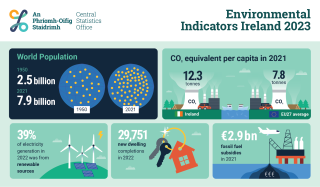Environmental Indicators Ireland 2023

‘Environmental Indicators Ireland 2023’ published by the CSO gives a snapshot of how Ireland is -performing over 10 themes including Greenhouse Gases, Air, Water, Land Use, Energy and Biodiversity. The report also indicates how Ireland is performing in relation to other EU Member States. Among the keys findings in the latest report is that the highest average annual temperature in Ireland over the 1961-2022 period occurred in 2022 at 10.61o Celsius. Ireland had the second highest emissions of greenhouse gases per capita in the EU27 in 2021 at 12.3 tonnes of CO2 equivalent.
Key Findings
- The highest average annual temperature in Ireland over the 1961-2022 period occurred in 2022 at 10.61o Celsius.
- Emissions of greenhouse gases by the EU27 fell by 29% from 4.9 billion tonnes of CO2 equivalent in 1990 to 3.5 billion tonnes in 2021. Emissions in Ireland rose by 9.2% from 55.6 million tonnes of CO2 equivalent in 1990 to 60.8 million tonnes in 2022.
- The percentage of dwellings completed between 2020 and 2022 in Ireland with an A energy rating was 99%.
- Ireland had the second highest emissions of greenhouse gases per capita in the EU27 in 2021 at 12.3 tonnes of CO2 equivalent.
- In 2022, 1% of urban waste water in Ireland received no treatment compared with 46% in 1997.
- Renewable energy accounted for 39% of electricity generation in Ireland in 2022 up from 5% in 1990.
- The proportion of municipal waste sent to landfill in Ireland fell from 74% in 2001 to 16% in 2021.
Environmental Economy
In 2021, €3.2 billion was raised in energy taxes in Ireland. Environment subsidies related to energy and air emissions were €697 million in 2021, while €2.9 billion was spent on fossil fuel subsidies. Environment taxes in Ireland amounted to €4.5 billion in 2022 which was down 8.6% on the 2021 figures of €5 billion.
Environment taxes as a percentage of total taxes at 4.3% in 2022 was the lowest over the 2000-2022 period and were considerably lower than the peak 9.2% figure of 2010. Energy taxes accounted for 61% of total environment taxes in 2022, while transport taxes accounted for 39% of the total. Pollution and Resource taxes contributed just 0.4% of total environment taxes in 2022.
Environmental subsides in Ireland were €1.6 billion in 2022, up 7% from the 2021 figure of €1.5 billion. Subsidies associated with the production of energy from renewable resources increased from 0% of all environmental subsidies in 2000 to 20% in 2022. Subsidies associated with wastewater management declined from 51% of total environment subsidies in 2000 to 29% in 2022. Subsidies associated with the protection of biodiversity fell from 33% to 13% over the period 2000 - 2022.
In 2021, consumers of petrol paid an average effective rate of €269 per tonne of carbon dioxide emitted. The average effective carbon rate on road diesel was 27% lower at €196 per tonne in 2021, with the difference mainly due to the lower excise tax on road diesel. The rate for jet kerosene was just €3 per tonne in 2021.
The consumer price index in Ireland increased significantly in 2022 for most energy products. The price index for electricity in 2022 was up 42% from 2021. Gas price figures in 2022 were up 59% from the 2021 figure. Autodiesel in 2022 was up 34% from its price in 2021.
Total networked gas consumption in Ireland in 2022 was 56,617 gigawatt hours, an increase of 2.2% compared with the consumption figure in 2021. Power plants accounted for 65% of total networked gas consumption in 2022 compared with 23% for the non-residential sector and 12% for the residential sector.
Total metered electricity consumption in Ireland was 29,500 GWh in 2022, an increase of 3.5% compared with 2021. Large energy users, such as the largest data centres and cement manufacturing, accounted for 27% of metered electricity consumption in 2022, up from 15% in 2015. The residential sector consumed 29% of metered electricity in 2022.
Greenhouse Gases and Climate Change
Ireland’s greenhouse gas emissions were 60.8 million tonnes of carbon dioxide equivalent in 2022. This was down from 62 million tonnes in 2021 but was 9.2% higher than the 1990 figure of 55.6 million tonnes. Ireland ranked fifth worst out of 27 EU Member States in terms of its total greenhouse gas emissions in 2021. In 2021, Ireland had the second highest emissions of greenhouse gases per capita in the EU27 at 12.3 tonnes of carbon dioxide equivalent per capita. Ireland’s emissions were 59% higher than the EU27 average of 7.8 tonnes.
Agriculture was the sector with the highest greenhouse gas emissions in Ireland over the 1990-2022 period accounting for 38% of the total CO2 equivalent in 2022. The transport share of greenhouse gas emissions increased from 9% in 1990 to 19% in 2022. The energy sector’s share of greenhouse gas emissions in 2022 was the third largest sectoral contributor to emissions with 17% of the total.
The highest average annual temperature in Ireland over the 1961-2022 period occurred in 2022 at 10.61° Celsius. The average annual rainfall in Ireland over the 1941-2022 period varied between 912 millimetres in 1971 and 1,506 millimetres in 2009. The average rainfall figure in 2022 was 1,268 millimetres.